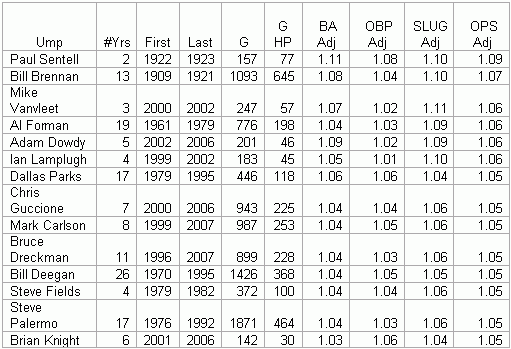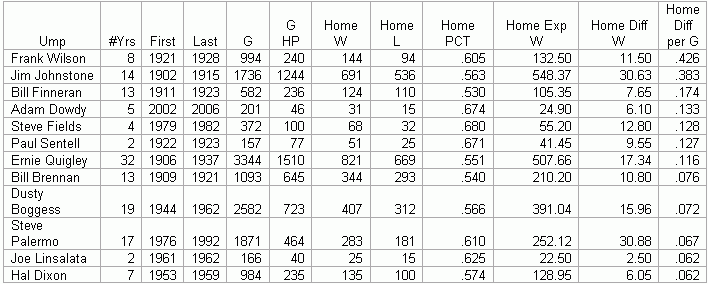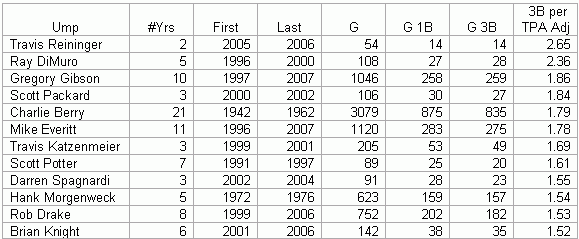BP Comment Quick Links

 | |
July 2, 2007 Watching the DetectivesHome Field Advantage
"Please do not shoot the umpire. He is doing the best he can."
"The thing that surprised me most in baseball is the amount of integrity that most umpires have. It actually took me a while to believe what a good game they'd give you the next night after a blow-up." Being an umpire in the early days of the game was a dangerous and underpaid proposition. Seemingly from the first time that Alexander Joy Cartwright and the Knickerbockers laid out the bases, there was someone complaining about an umpire's call. As Albert Goodwill Spalding once said, "To secure the presence of intelligent, honest, unprejudiced, quick-witted, courageous umpires at all contests in scheduled games has been one of the most vexatious problems confronting those in control of our national sport." Homerism was suspected from the start. Since the threat from locals was very often real, it is not surprising that close calls may have favored the home team. In the early days of "base ball," when the game's name was still two words and the players were at least ostensibly amateurs, both the home and traveling teams supplied umpires, while a neutral "referee" arbitrated any split decisions. That was until the National Association of Base Ball Players (at least the titular forebear of the first professional league, the National Association) changed the rules in 1858 to require one sole umpire, usually picked by the home team with the visitor's approval. In 1871, the NA changed the umpire selection process to avoid homer umps by requiring the home team to pick the ump from a list of five candidates submitted by the visiting team. In its first season (1876), the National League employed 61 different umpires, 13 of whom were active players, for an eight-team league, or 15.25 per possible scheduled game, the highest ratio until the 1979 umpire strike. Finally, the National League soon created the first official umpiring staff (reportedly in 1879, but the umpire staff was actually down to eight for six NL clubs in 1878). Still "homer"-ism and gambling influence persisted. Leagues combated this with better pay and more support for their umps and through more stringent rules for both combative players and dirty umps, but the process took decades to complete. Prizefighter turned National League umpire Billy McLean (rightfully dubbed "King of Umpires") demanded that baseball arbiters be paid for their services, and won--a whole $5, paid by the home team starting in 1878. Nevertheless, in 1882 the NL expelled umpire Dick Hingham for dishonesty; he would advise local gamblers on how to bet on the games he umpired. The next year the NL-rival American Association made the umpires employees of the league, paid them $140 a month plus a $3 per diem for "traveling expenses and hotel bills," and assigned them to games. However, intimidation continued, in part due to the NL not allowing umpires to eject players. As Burt Solomon noted in his book Where They Ain't: "Steve Brodie once pulled off an umpire's mask and cap. McGraw and Jennings and Kelley would surround a man in blue and walk him backward all over the diamond." Perhaps the greatest champion for umpire's rights during the game's development was American League founder and president Ban Johnson, who doggedly supported his on-field officials starting when the AL was the minor league-level Western League. Johnson's support of umpires was evident in the first year of the AL, when it was not yet a major league (1900), according to the Reach Guide-"There was less disorder in the field than the other league [the NL], owing to the vigilance of Ban Johnson in protecting umpires." How strong was this stance? "This is the first time a player in the American League has struck an umpire, and it is an offense that cannot be overlooked," said Johnson in suspending Oriole first baseman Burt Hart on August 7, 1901 for hitting umpire John Haskell a day earlier. Hart was released by the O's on August 25 and never played in the majors again. Johnson also added a second umpire to the game to buttress the man behind the plate, something that would not become standard in the National League until almost a decade later. The second ump would handle the calls in the field and on the base paths-no more short cuts around the bases a la the old Baltimore Orioles-while the plate ump took on his current role. The new ump also supported both the plate ump's opinions and (sometimes) his physical well-being. Ump Pants Rowland said of Johnson, "all umpires ought to tip their hats whenever Ban Johnson's name is mentioned." The practice of using active players as umpires was still common at the turn of the twentieth century though Ban Johnson's commitment to professionalizing their ranks soon drove the players out. Here are the decade totals for all umpire seasons through the Twenties, with the percentage of umps that were also active players; note that the 1870s include just the NL, not NA, totals:
 As the role of umpire became a true profession, it was provided with an air of respectability, helping to reduce the frequency and severity of attacks both physical and verbal on his person, but they have never been completely driven out. Personal attacks on umpires by the fans were part of the game in the nineteenth century. In Baseball Immortals, Mac Davis recounts a melee on what is reported to be the first Ladies Day in September, 1897, possibly on the 13th. Washington starting pitcher and women's favorite Win Mercer stepped off the mound in the fifth inning and offered rookie umpire Bill Carpenter a pair of glasses, or rather spectacles. Carpenter counter offered with a trip to the showers (or rather baths):
In You're Out and You're Ugly, Too!: Confessions of an Umpire with Attitude, Durwood Merrill relates the misadventures that umpires encounter in the minors: I'd been through a lot my first couple of years of professional umpiring. But nothing really scared me until I got to Amarillo, Texas, that first season in the Texas League. My partner that night was a skinny guy from Philadelphia named Bob Nelson, who was about five-foot-eight. [Nelson also umped in the majors sporadically from 1979 to 1995.] And we'd had a rough night on the Texas Panhandle. It had been a real rodeo. We'd tossed out several players and both managers, and the crowd was getting restless. (There was once a minor league umpire [who also umpired in the majors one season in 1914 during the Federal League wars] named Harry "Steamboat" Johnson who claimed that some cowboys pulled their guns in the bleachers and blew a home run ball to smithereens. It wasn't that bad in Amarillo. But it was doggone close.) The latest reported attack on a big league umpire that I could find was on April 15, 2003, when a deranged fan grabbed first base umpire Laz Diaz around the waist as a flyball was hit into the right field bleachers at U.S. Cellular Field less than a year after the attack on Royals coach Tom Gamboa in the same park. As for player attacks on umps, there are a few in recent memory that come to mind ranging, from the Roberto Alomar-John Hirschbeck spitting incident, to Pete Rose shoving Dave Pallone, Earl Weaver slapping Terry Cooney, Bill Madlock shoving his glove into Jerry Crawford's face almost causing an umpire strike, and finally, there was Delmon Young's bat-throwing incident in the minors last spring-Steven Goldman has a full rundown here. One has to wonder if intimidation works. Are umpires swayed by the sentiment of the more vocal elements on the field or in the crowd? As for the players, managers, and coaches, one has to think that the support umpires receive from Major League Baseball gives them the freedom to make their calls free of outside influences. One would assume on-field intimidation emanates equally from the home and the road team, for the most part. However, there have always been theories as to certain umpires being "homer" umps; that is, umpires who seem to support (or pander to) the local nine whenever there is a close call to be made to appease the local natives. Can we look at each home plate umpire's win-loss record and their tendencies in calling balls and strikes for home teams as opposed to road teams over his entire career and somehow derive those umps who meet the criteria for a homer ump? To quote Mr. Owl, let's find outů First, we need to isolate and adjust for the home field advantage in the given era (i.e., league and year). Here are the overall home winning percentages based on the home plate umpire totals per decade (all data through 2006):
 Note that as umpiring became more professional and respected (i.e., by the 1910s), home winning percentages came in line with what they are today. Now, here are the home-to-visitor (HtoV) ratios for the umpiring stats that we have tracked so far for all decades with data; note that for the most part these ratios have remained remarkably consistent over time:
 Now here are the same ratios by league (ML=major league, i.e., designates those seasons in which umpires were shared among leagues); again, the ratios are pretty consistent across leagues:
 We can adjust each individual's home-to-away ratios for their era and come up with the adjusted career numbers. Here are the plate umpires who had the highest home-to-road adjusted OPS figures in the games they called:
 Now, here are plate umps that witnessed OPS ratios for home and road teams closest to the norm, which would indicate that these umps had no home bias. OPS is expanded to four digits to see the variation:
 Here are the plate umps who were the most likely to call more walks and fewer strikeouts for the home team rather than the visitors. It is based on the ratio of walk and strikeout-to-plate appearance rates adjusted for era. Note that only a few appear on the lopsided OPS list above:
 Here are the umpires who were more likely to call more walks and fewer walks for the visitors rather than the home team:
 Below are the umps with the least discernible bias towards the home team when it comes to strikeouts and walks:
 So what does it all mean? If you are the home team, which ump do you want to see behind the plate? Which plate umpires have recorded the best winning percentage for the home team? Here they are (min. 25 career games behind the plate):
 A number of current or recent umpires show up on the list, but the home winning percentage has varied over time. What if we adjust the winning percentage by era (i.e., league and year average)? I did this by expressing the wins for the home team over what would be expected for the era (i.e., Home Exp W). Then I prorated the wins above expected (Home Diff W) by the number of games that the ump called (G HP) in order to prorate it over his entire career (Home Diff per G):
 As for bias in first base umpires, here are the most likely to witness better stolen base rates, i.e., fewer pickoffs, for the home team:
 And here are the ones who called higher double-play groundouts for the visitors:
 Here are the same statistics for second base umps. First, SB %:  ...then GIDP:
 For corner umps, here are the ones most likely to call doubles for the home team:
 ...and here are the ones most likely to call triples for the home team.
 In the next, final installment in this series, we will look at how umpires age. Note: In Part Two of this series, I listed Frank Wilson as twenty times more likely than the average first base umpire to call runners out on a double play ground ball. However, his data was skewed due to an aberration. Wilson split his time between the NL and AL in for 1922, a year for which there is no GIDP data for AL umps. His partial NL data skewed the rest of the data given that no data was AL data, throwing off his league-adjusted average. Wilson was the only ump affected by this anomaly. Mike Carminati is the author of Mike's Baseball Rants. You can reach Mike by clicking here.
|